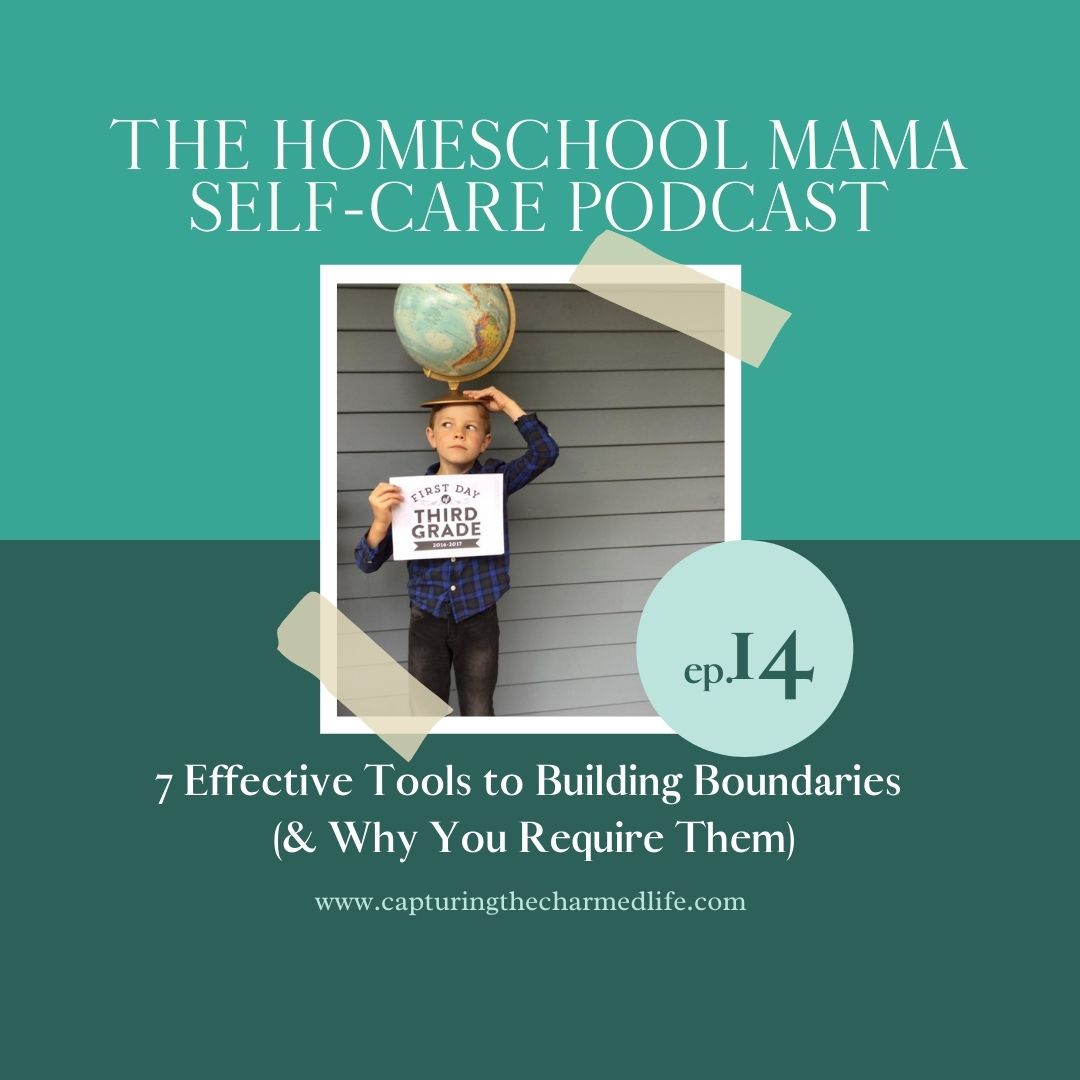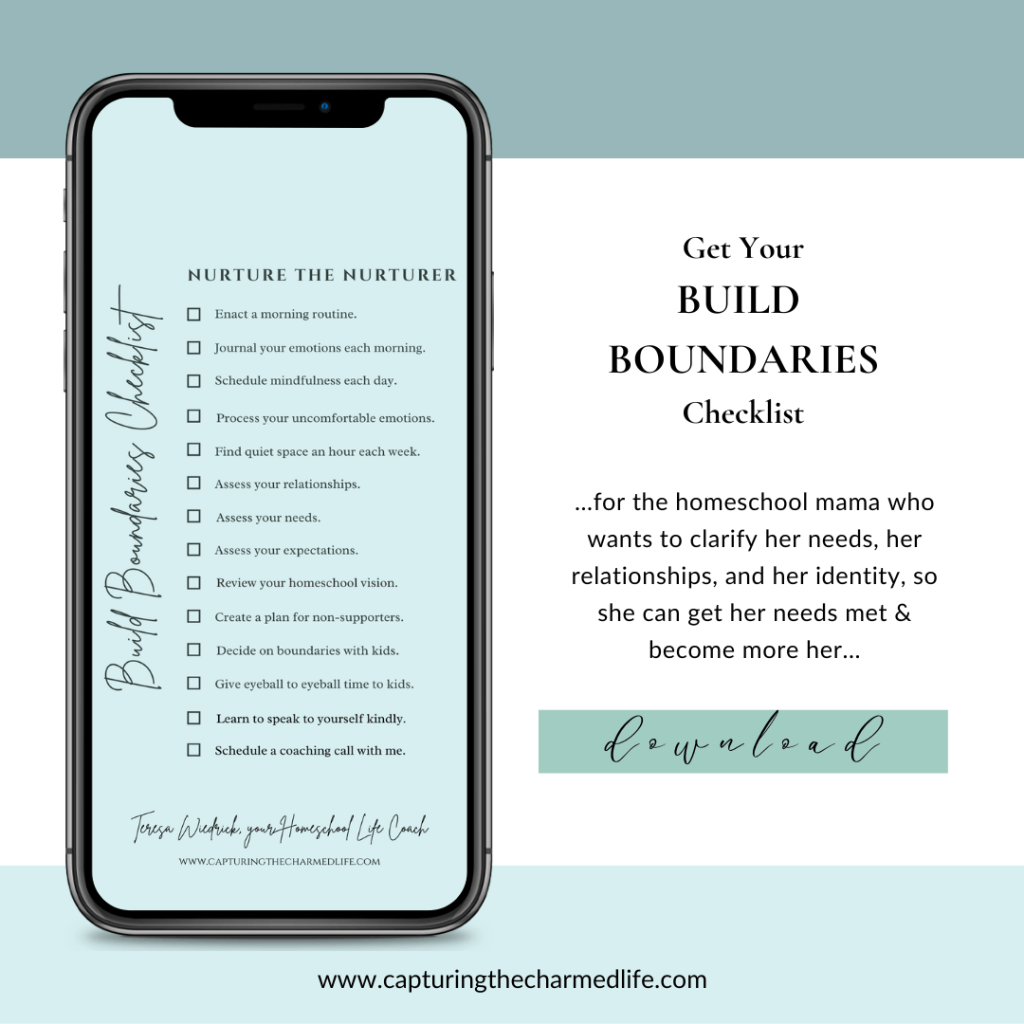Podcast: Play in new window | Download
What are the effective tools to build boundaries as a homeschool mama? (And how do we even know if we need them?)
Turns out, boundaries are a continual challenge to instill in our homeschools.
I offer 7 effective tools to build boundaries (& why you require them).
I spent the morning rolling my chair back and forth between three little girls doing their cursive, then their math workbooks, and then their spelling.
My toddler was mostly satisfied strapped into his high chair with a bowl of cheerios, tossing them off the side until he needed more, and he made sure I knew when he did.
I needed a break, a little quiet, to sequester myself in the corner chair of my bedroom, pull out the box of Italian cookies hidden under my cushion, and scroll Pinterest for a few mindless minutes.
I needed a breather.
We homeschool mamas have a unique challenge & privilege at the same time: we signed up to be with our children.
- We might need a little quiet in our homes.
- We might need some time away from our kids.
- We might need a clean house in order to feel sane.
These are clearly challenges.
So how do I create boundaries around my time, around disrespectful behaviour, around my need for quiet, around my need for separate toilet time, and maybe even a temporarily clean home?
Boundaries are simply this: you respect yourself, then expect others to respect you too.
So why do you want effective tools to build boundaries?
The boundaries you maintain around your energy, needs, and goals will help you maintain…
- your peace
- your quiet
- your cleanliness
- your organization
- your relationships
- help build energy into you
When our needs and goals are met, we have energy and mental space to extend nurture to those around us too.
Effective tools to build boundaries can help you do this because…
- they prevent us from sapping our energy
- they help us get our needs met
- they help other people get their needs met too
- they affect how eager we are to engage our kids
- they influence how satisfied we are in our homeschool days
- they’re necessary for our kids as much as they are for us
- we teach our kids what to expect in relationships, how to engage respectfully, and how to get their needs met too
- we increase our satisfaction during our homeschool days
What kinds of boundaries do we instill?
Consider that boundaries are subjective: what you value and what I value aren’t the same.
Maybe you don’t value a clean house. I’ve met that mom. She was so messy, but also far more content with her kids. To each her own.
We need to create at-home work boundaries.
Some of us moms are trying to work from home while homeschooling. For my creative writing to expand, I like to write in quiet. Mwahaha. (You know where I’m going). This has been a challenge, to say the least. Over the years my kids have learned (most days) that if I am tapping on my laptop or my study door is closed, I am unavailable.
We need to create morning boundaries.
I insist on fifteen minutes of early morning quiet for my brain to wake up with a cup of coffee, daily reading, and a journal entry. As I’m aging, I wake up in ridiculously early hours, so I don’t have to work at it. Teenagers don’t wake up at 5.
How to accomplish morning boundaries with younger kids: For some three-year-olds, fifteen minutes of quiet might be too long. Consider purchasing an alarm clock and setting the alarm to 7 o’clock. They’re up at six, you say. The alarm is for them to stay IN their room. Let them know when the alarm goes off, they can come to greet you then. Make sure they’re set up with a few toys, books, and a snack just for the morning, so they have something to do. (And I know, this idea would never have worked with one of my girls, but it worked with the other three.)
Build on your time apart.
Consider setting a boundary on your toilet time.
If the door is closed, no one can talk to you, unless the house is on fire.
Direct them to scream, THE HOUSE IS ON FIRE!
And the house better is on fire. Stretch toilet time to ten minutes, then eleven, then twelve.
Bring in a book and a cup of coffee. (At what age do you start? If they don’t know what a fire is, or they don’t have the verbal skills to yell, “The house is on fire,” they’re too young.)
Build boundaries with non-supporters.
When you’re not feeling the love from the general public or an unsupportive relative or when you regularly hear comments like “Why aren’t the kids in school? Is it legal? Do you have teaching certification?”
Remind yourself: you do not have to be a representative of the homeschool world.
People are often just surprised by an unconventional choice or wondering if there’s a holiday. They might benefit from hearing your reasons for your homeschool preference.
If you’ve been asked something regularly, be prepared to answer, but determine your answers in advance. No sass is required.
Build boundaries into your homeschool day.
If you’re not an unschooler, and you’re occupied in your study routine, don’t answer the phone.
Determine your study hours, let the regular people in your life know those study hours, and they will learn to honour them as you insist these boundaries are as necessary as punching a clock in a workplace.
Build cleanliness boundaries.
Maybe you want to teach your kids, “Keep your room clean, flush the toilet after you use it, wash your hands after you use the toilet, wipe the bathroom wall after you pee (boy mamas unite!).”
You can teach them whatever is essential to you.
Yes, the wall will still gradually yellow because they are learning. They’re not mini janitors. But you gotta start somewhere.
Teach kindness boundaries.
- Teach them not to interrupt their siblings.
- Teach them to be patient.
- Teach them to listen to each other and to you.
- Teach them to repeat back what they’ve heard their sibling say so they actually learn how to listen.
Expect great things from their sibling relationships and assume this is the ultimate training ground for their future relationships.
However, assume their immaturity in relating will continue throughout childhood.
Caveat: small children are natural boundary breakers.
If you have small children, the notion of boundaries is nebulous at best. What boundaries do you expect from a child who is six? Or ten? Just remember, kids don’t get magic boundary pills. You gotta teach ‘em.
Assume boundaries will take a while to learn.
Assume you really will be repeating yourself a million times.
Give yourself a break: expect boundaries won’t be established quickly or without mistakes.
Boundaries are taught over time.
How do we effectively instill boundaries (& maintain them)?
1. Observe yourself: be still.
A powerful tool for understanding ourselves is to sit and listen to our uncomfortable feelings.
- Why do we feel what we feel?
- What are my real feelings right now?
- Be gracious with ourselves and don’t judge our feelings as good or bad, but observe them instead.
- What are our boundary challenges?
- What’s really going on in our relationships?
2. Accept all your feelings.
So you’re still, now you need to accept that you are human and humans feel all sorts of feelings:
- disappointment
- disgust
- overwhelm
- sadness
- frustration
- contempt
- glee
- elation
Recognize that feelings often pass like clouds in the sky: they don’t stay static, yet they’re not entirely predictable either.
But humans have all these feelings, so accept all these feelings in you.
Teresa Wiedrick, author of Homeschool Mama Self-Care: Nurturing the Nurturer
3. Maintain alone time.
Do you have time to be with yourself, by yourself, on the regular?
4. Maintain an-all-about-you thing.
Energizing activities.
For me, writing, gardening, reading, and nature.
For you, needlepoint, poetry, 1950s deco, clothing design, makeup techniques, or travel blogs? You tell me.
Whatever it is, do it every day. Just 15 minutes. You can do that or you can learn to do that (and your kids will learn that you are indeed going to do that).
Here are two podcasts with two seasoned homeschool mamas:
- A chat with Julie Bogart on How to Homeschool & Find your Homeschool Mama Thing
- A chat with Pat Fenner on Your Homeschool Mom Identity
- A chat with Stacy Wilson on Building Boundaries and Requiring Time for Ourselves as Homeschool Moms
5. Get your regular dose of quiet time.
- A hot cup of coffee or mint tea before anyone talks with you.
- Quiet space to think.
- Quiet space to determine our thoughts toward our day.
- Time to journal, plan, and be quiet.
- Listen to this podcast about the life of a perpetual mother hen.
6. Speak to yourself kindly.
How we speak to ourselves matters. Funny that in regular conversations about boundaries, we’re often referring to the boundary-breaking of OTHER people, but sometimes the worst boundary-breakers are ourselves.
We have to practice thinking the right thoughts. So stick this thought care checklist into your journal and assess how you’re speaking to yourself.
- Are you kind to yourself?
- Are you speaking the truth to yourself?
- Would you speak like this to your friend?
- How can you change you speak to yourself?
Include your daily homeschool mama affirmations to be intentional in your thoughts each morning as you brush your teeth.
7. Make yourself accountable.
Access a homeschool mama coach (me) or a counselor/therapist to help guide our boundary challenges into boundary freedom.
Book a one-on-one coaching session with me (the first session fee is waived).
Sure, it’s a challenge to build boundaries into our homeschool lives, but it can be done and it will provide so much freedom.
Check out the interactive, self-directed course for Homeschool Moms wanting to build boundaries, foster stronger connections, and get your needs met…

Building Boundaries for Homeschool Mama Coaching Course
Begin a transformative journey with the self-directed course, “Foundations of Homeschool Mom Fulfillment: Building Boundaries for the Homeschool Mama.” Tailored for homeschool mamas seeking fulfillment, stronger relationships, and intentional living, this course empowers you to clarify your needs, navigate relationship challenges, and rediscover your identity. With practical tools and actionable steps, this course is designed to address boundary challenges, foster stronger connections, and guide you toward becoming a more intentional and fulfilled version of yourself.
People also ask:
- How to Develop Boundaries in your Homeschool Life
- Practical (& useful) steps to boundaries in your homeschool
- 7 ways to find quiet, handle overwhelm & build boundaries in your homeschool
- 7 Effective Tools to Build Boundaries (& Why You Require Them)
- A Homeschool Mom Podcast for Boundary Breakthrough
Call to Adventure by Kevin MacLeod
Link: https://incompetech.filmmusic.io/song/3470-call-to-adventure
License: http://creativecommons.org/licenses/by/4.0/


